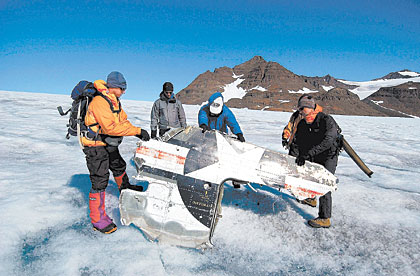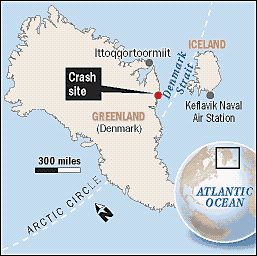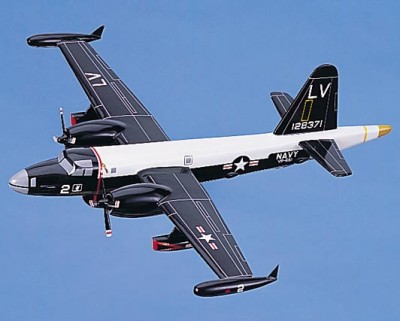
Posted on 08/19/2004 3:22:36 AM PDT by csvset
Lost crew heading home after 42 years in icy grave
By KATE WILTROUT, The Virginian-Pilot
© August 19, 2004
Last updated: 12:23 AM
 |
| Cmdr. Charles Huff, chief aviation mishap investigator for the Navy Safety Center, inspects the wreckage of the ill-fated Lima Alpha Nine , a Navy P-2V Neptune aircraft that crashed in Greenland in 1962. Petty Officer 2nd Class jeffrey lehrberg/U.S. Navy
|
 |
But after 42 years and two recovery efforts, the remains of a P-2V Neptune crew that crashed in Greenland in 1962 are finally on their way home. Headed by a Norfolk fighter pilot, a team of 16 people and two dogs spent 10 days on the Kronborg glacier searching for the crew of the ill-fated plane known as Lima Alpha Nine.
Local members of a diverse recovery team – which included British mountaineering experts versed in Arctic trekking, a Hawaii-based forensic anthropologist, and cadaver dogs and their civilian handlers from Pennsylvania – returned to Norfolk early Wednesday morning.
The human remains are en route to a military facility in Hawaii that works to repatriate the bodies of missing service members. A limited recovery mission in 1966 during blizzard conditions brought back the bodies of seven of the 12 crewmen and the partial remains of three others.
Capt. Tom Sparks , who led the recovery effort for the Naval Air Force U.S. Atlantic Fleet , said he could not provide specifics about human remains and personal effects the team discovered. But he described the mission as “100 percent successful ” and hopes the trip will help families and friends of the missing fliers to close a chapter that has been open too long.
The group actually came across an open book – a thick airplane manual laying open, its pages wet but readable. During the week, the wind dried it out, until the paper flaked and blew away.
The recovery effort was timed to take advantage of unusually warm weather, Sparks said.
Retrieving artifacts from the glacier is possible only during a few weeks in the summer, when snow and ice melt to reveal what lies beneath. But because of wind, water and time, what had been a debris field the size of two football fields in 1966 now stretched over six square miles , Sparks said. Cadaver dogs found human remains and personal effects over an area the size of four football fields.
To search the area, Sparks said they cordoned off 15-meter blocks and combed the area centimeter by centimeter – sometimes on hands and knees. To make sure they weren’t missing pieces of the plane buried beneath the ice, the crew used ground-penetrating radar that detects ferrous metals.
During their time on the glacier – living in tents and working long days under a sky that never got dark – Sparks said they literally watched wreckage emerge. The glacier melted a few feet each day, which sometimes meant that pieces of the plane would warm up in the sun, then sink into pools of freezing water.
Temperatures during the day were 35 to 40 degrees ; nights were usually in the teens, but felt colder in the wind. One windy night, gusts reached 55 mph, Sparks said, shredding a tent and scattering some of their supplies.
His face still red from sunburn and wind burn, Sparks said the crew relied on the expertise of six contractors who traveled with them from Tangent Expeditions , a British company. The dogs – one golden retriever, the other a German shepherd – and their handlers came from a Pennsylvania search and rescue group. Also accompanying them was a Navy combat photographer, a hospital corpsman assigned to the carrier Theodore Roosevelt and a forensic anthropologist from the Joint POW/MIA Accounting Command in Hawaii.
Sparks said expedition members each dealt with the emotional effects of the work in their own way, though they did hold a memorial service before the helicopter returned to pluck them off the glacier.
As a pilot himself, Sparks said he took satisfaction in helping fellow aviators’ families find closure.
“From a personal satisfaction standpoint, it just felt like the right thing to do ... as an aviator, to help out a fellow shipmate and recover the known remains that are out there,” Sparks said.
Navy spokesmen said casualty assistance officers would notify the crew members’ families about the results of the mission. Sparks said he hopes to talk to surviving family members directly to describe what they found on the glacier. And he hopes to usher the remains through analysis faster than usual.
Typically, Sparks said, it takes military researchers a year or two to complete DNA testing and return remains to families. He said he hopes to see the final phase completed in four to six months.
“This is, in my opinion, a high-visibility case, I’m very much interested in it, and I’m doing everything I can to push that time frame up,” Sparks said.
Though the recovery effort wasn’t cheap – he figures it cost $250,000 – it was far below initial estimates of $10 million , he said.
“That sounds expensive, but it truly was a bargain,” Sparks said. “People have moved on in their lives. They’ve moved forward. This brings closure to them.”
Reach Kate Wiltrout at 446-2629 or kate.wiltrout@pilotonline.com

This should give some closure to the families after all these years.
Nice story..thanks..Question..if a family years ago received "partial remains"..they obviously held a burial service, had "closure" to use that much overused word, and went on with their lives...If, years later, additinal remains are identified...is another service held, or is the casket exumed, and the newly identified remains combined? Is their protocol for this, or is it a religious issue, or up to the individual families involved?

Rest In Peace.
I'm not sure what the protocol is in a case like this. I'd imagine that the family has a say as to the final internment.
Did they use to jets to get up to altitude and the props for cruising?
VPer Bump
C'mon home boys. We're grateful, and we're proud of you.
My late Dad flew sub chasers in this neck of the woods in the late 50's in Patrol Squadron 10 based in Brunswick ME. I believe they were P-2Bs, though, but I could be mistaken.
He had two tours in Iceland. Suspect that is where he learned to play poker. Wonder if it was the same squadron.
Welcome home, shipmates.
May you rest in eternal peace.
We bring our men home.
Ping!
Semper Fi
The jets were used primarily for takeoffs and landings. Once at altitude and/or onstation, the jets would be shut down to conserve fuel and extend range.
Thanks for the ping Snopercod.
Heather Nauert of Fox News did a story on these guys a while back and that story is credited with pushing the Navy to go back for them.
Thanks for relating your sad experience, Mr. LaFond.
The P2V I saw being built had a million-candlepower arc light under one wing. IIRC, it had a parabolic reflector about 16" in diameter.
Disclaimer: Opinions posted on Free Republic are those of the individual posters and do not necessarily represent the opinion of Free Republic or its management. All materials posted herein are protected by copyright law and the exemption for fair use of copyrighted works.